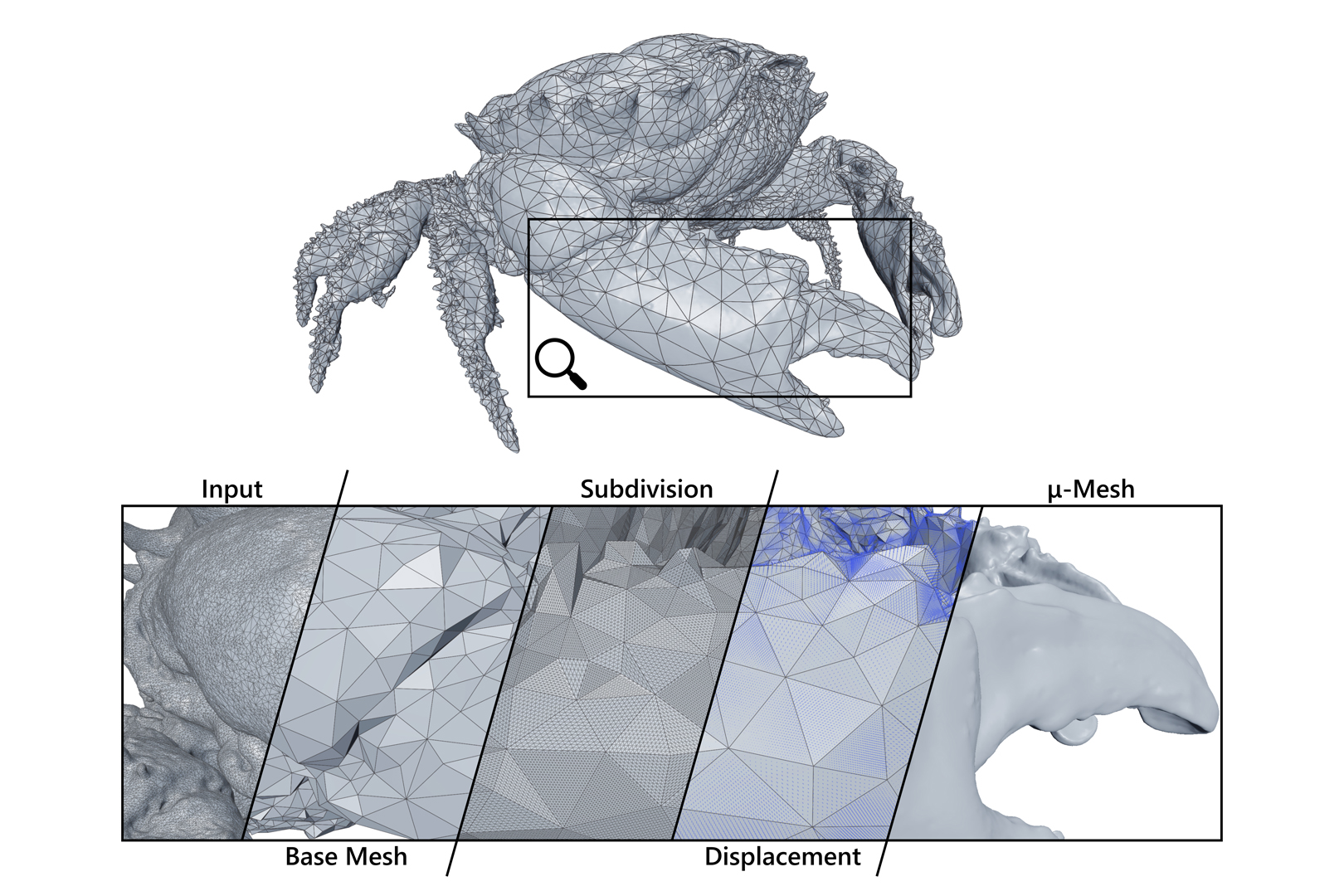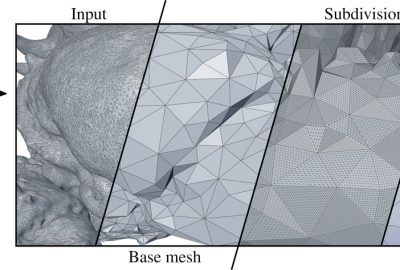“Micro-Mesh Construction” by Maggiordomo, Moreton and Tarini
Conference:
Type(s):
Title:
- Micro-Mesh Construction
Session/Category Title: All About Meshes
Presenter(s)/Author(s):
Moderator(s):
Abstract:
Micro-meshes (μ-meshes) are a new structured graphics primitive supporting a large increase in geometric fidelity, without commensurate memory and run-time processing costs, consisting of a base mesh enriched by a displacement map. A new generation of GPUs supports this structure with native hardware μ-mesh ray-tracing, that leverages a self-bounding, compressed displacement mapping scheme to achieve these efficiencies.In this paper, we present anautomatic method to convert an existing multi-million triangle mesh into this compact format, unlocking the advantages of the data representation for a large number of scenarios. We identify the requirements for high-quality μ-meshes, and show how existing re-meshing and displacement-map baking tools are ill-suited for their generation. Our method is based on a simplification scheme tailored to the generation of high-quality base meshes, optimized for tessellation and displacement sampling, in conjunction with algorithms for determining displacement vectors to control the direction and range of displacements. We also explore the optimization of μ-meshes for texture maps and the representation of boundaries.We demonstrate our method with extensive batch processing, converting an existing collection of high-resolution scanned models to the micro-mesh representation, providing an open-source reference implementation, and, as additional material, the data and an inspection tool.
References:
1. Adobe. 2021. Bake Mesh Maps. Substance 3D Documentation, https://helpx.adobe.com/substance-3d-painter/using/baking.html.
2. Pierre Alliez, ?ric Colin de Verdi?re, Olivier Devillers, and Martin Isenburg. 2005. Centroidal Voronoi diagrams for isotropic surface remeshing. Graphical Models 67, 3 (2005), 204–231. Special Issue on SMI 2003.
3. Romain Aubry and Rainald L?hner. 2008. On the ‘most normal’ normal. Communications in Numerical Methods in Engineering 24, 12 (2008), 1641–1652.
4. Blender Development Team. 2022. Blender. Blender Project. https://blender.org
5. Mario Botsch and Leif Kobbelt. 2004. A Remeshing Approach to Multiresolution Modeling. In Proceedings of the 2004 Eurographics/ACM SIGGRAPH Symposium on Geometry Processing (Nice, France) (SGP ’04). Association for Computing Machinery, 185–192.
6. Tamy Boubekeur and Christophe Schlick. 2008. A Flexible Kernel for Adaptive Mesh Refinement on GPU. Computer Graphics Forum (2008).
7. Paolo Cignoni, Marco Callieri, Massimiliano Corsini, Matteo Dellepiane, Fabio Ganovelli, and Guido Ranzuglia. 2008. MeshLab: an Open-Source Mesh Processing Tool. In Eurographics Italian Chapter Conference, Vittorio Scarano, Rosario De Chiara, and Ugo Erra (Eds.). The Eurographics Association.
8. Paolo Cignoni, Fabio Ganovelli, Enrico Gobbetti, Fabio Marton, Federico Ponchio, and Roberto Scopigno. 2003. BDAM: Batched Dynamic Adaptive Meshes for High Performance Terrain Visualization. Computer Graphics Forum 22, 3 (sept 2003), 505–514.
9. Paolo Cignoni, Fabio Ganovelli, Enrico Gobbetti, Fabio Marton, Federico Ponchio, and Roberto Scopigno. 2004. Adaptive Tetrapuzzles: Efficient out-of-Core Construction and Visualization of Gigantic Multiresolution Polygonal Models. ACM Trans. Graph. 23, 3 (aug 2004), 796–803.
10. Paolo Cignoni, Claudio Montani, Claudio Rocchini, Roberto Scopigno, and Marco Tarini. 1999. Preserving attribute values on simplified meshes by resampling detail textures. The Visual Computer 15, 10 (1999), 519–539.
11. Jonathan Cohen, Dinesh Manocha, and Marc Olano. 1997. Simplifying Polygonal Models Using Successive Mappings. In Proceedings of the 8th Conference on Visualization ’97 (Phoenix, Arizona, USA) (VIS ’97). IEEE Computer Society Press, 395–ff.
12. Jonathan Cohen, Marc Olano, and Dinesh Manocha. 1998. Appearance-Preserving Simplification. In Proceedings of the 25th Annual Conference on Computer Graphics and Interactive Techniques (SIGGRAPH ’98). Association for Computing Machinery, 115–122.
13. Gordon Collins and Adrian Hilton. 2002. Mesh Decimation for Displacement Mapping. In Eurographics 2002 – Short Presentations. Eurographics Association.
14. Robert L. Cook. 1984. Shade Trees. SIGGRAPH Comput. Graph. 18, 3 (jan 1984), 223–231.
15. Leila De Floriani, Paola Magillo, and Enrico Puppo. 1998. Efficient implementation of multi-triangulations. In Proceedings Visualization ’98 (Cat. No.98CB36276). 43–50.
16. Tamal K Dey, Herbert Edelsbrunner, Sumanta Guha, and Dmitry V Nekhayev. 1999. Topology Preserving Edge Contraction. Publications de l’Institut Math?matique 86 (1999), 23–45.
17. David A. Field. 2000. Qualitative measures for initial meshes. Internat. J. Numer. Methods Engrg. 47, 4 (2000), 887–906. <887::AID-NME804>3.0.CO;2-H
18. Michael Garland and Paul S. Heckbert. 1997. Surface Simplification Using Quadric Error Metrics. In Proceedings of the 24th Annual Conference on Computer Graphics and Interactive Techniques (SIGGRAPH ’97). ACM Press/Addison-Wesley Publishing Co., 209–216.
19. Michael Garland and Paul S. Heckbert. 1998. Simplifying surfaces with color and texture using quadric error metrics. In Proceedings Visualization ’98 (Cat. No.98CB36276). 263–269.
20. Michael Garland and Yuan Zhou. 2005. Quadric-Based Simplification in Any Dimension. ACM Trans. Graph. 24, 2 (apr 2005), 209–239.
21. Igor Guskov, Kiril Vidim?e, Wim Sweldens, and Peter Schr?der. 2000. Normal Meshes. In Proceedings of the 27th Annual Conference on Computer Graphics and Interactive Techniques (SIGGRAPH ’00). ACM Press/Addison-Wesley Publishing Co., 95–102.
22. Autodesk Help. 2021. Transfer Maps. Autodesk Knowledge Network, https://knowledge.autodesk.com/support/maya/learn?s=Transfer+Maps.
23. Hugues Hoppe. 1996. Progressive Meshes. In Proceedings of the 23rd Annual Conference on Computer Graphics and Interactive Techniques (SIGGRAPH ’96). Association for Computing Machinery, 99–108.
24. Hugues Hoppe. 1999. New quadric metric for simplifying meshes with appearance attributes. In Proceedings Visualization ’99 (Cat. No.99CB37067). 59–510.
25. Hugues Hoppe, Tony DeRose, Tom Duchamp, John McDonald, and Werner Stuetzle. 1993. Mesh Optimization. In Proceedings of the 20th Annual Conference on Computer Graphics and Interactive Techniques (Anaheim, CA) (SIGGRAPH ’93). Association for Computing Machinery, 19–26.
26. Kaimo Hu, Dong-Ming Yan, David Bommes, Pierre Alliez, and Bedrich Benes. 2017. Error-Bounded and Feature Preserving Surface Remeshing with Minimal Angle Improvement. IEEE Transactions on Visualization and Computer Graphics 23, 12 (2017), 2560–2573.
27. Wenzel Jakob, Marco Tarini, Daniele Panozzo, and Olga Sorkine-Hornung. 2015. Instant Field-Aligned Meshes. ACM Trans. Graph. 34, 6, Article 189 (nov 2015), 15 pages.
28. Zhongshi Jiang, Teseo Schneider, Denis Zorin, and Daniele Panozzo. 2020. Bijective Projection in a Shell. ACM Trans. Graph. 39, 6, Article 247 (nov 2020), 18 pages.
29. Zhongshi Jiang, Ziyi Zhang, Yixin Hu, Teseo Schneider, Denis Zorin, and Daniele Panozzo. 2021. Bijective and Coarse High-Order Tetrahedral Meshes. ACM Trans. Graph. 40, 4, Article 157 (jul 2021), 16 pages.
30. Brian Karis, Rune Stubbe, and Graham Wihlidal. 2021. Nanite – A Deep Dive. In Advances in Real-Time Rendering in Games. ACM SIGGRAPH 2021 Courses) (Virtual) (SIGGRAPH ’21).
31. Dawar Khan, Alexander Plopski, Yuichiro Fujimoto, Masayuki Kanbara, Gul Jabeen, Yongjie Jessica Zhang, Xiaopeng Zhang, and Hirokazu Kato. 2022. Surface Remeshing: A Systematic Literature Review of Methods and Research Directions. IEEE Transactions on Visualization and Computer Graphics 28, 3 (2022), 1680–1713.
32. Deok-Soo Kim, Panos Y. Papalambros, and Tony C. Woo. 1995. Tangent, normal, and visibility cones on B?zier surfaces. Computer Aided Geometric Design 12, 3 (1995), 305–320.
33. Aaron Lee, Henry Moreton, and Hugues Hoppe. 2000. Displaced Subdivision Surfaces. In Proceedings of the 27th Annual Conference on Computer Graphics and Interactive Techniques (SIGGRAPH ’00). ACM Press/Addison-Wesley Publishing Co., 85–94.
34. Peter Lindstrom and Greg Turk. 2000. Image-Driven Simplification. ACM Trans. Graph. 19, 3 (jul 2000), 204–241.
35. Ligang Liu, Lei Zhang, Yin Xu, Craig Gotsman, and Steven J. Gortler. 2008. A Local/Global Approach to Mesh Parameterization. In Proceedings of the Symposium on Geometry Processing (Copenhagen, Denmark) (SGP ’08). Eurographics Association, 1495–1504.
36. Yang Liu, Wenping Wang, Bruno L?vy, Feng Sun, Dong-Ming Yan, Lin Lu, and Chenglei Yang. 2009. On Centroidal Voronoi Tessellation—Energy Smoothness and Fast Computation. ACM Trans. Graph. 28, 4, Article 101 (sep 2009), 17 pages.
37. Haik Lorenz and J?rgen D?llner. 2008. Dynamic mesh refinement on GPU using geometry shaders. (2008).
38. David P. Luebke. 2001. A developer’s survey of polygonal simplification algorithms. IEEE Computer Graphics and Applications 21, 3 (2001), 24–35.
39. Andrea Maggiordomo, Paolo Cignoni, and Marco Tarini. 2021. Texture Defragmentation for Photo-Reconstructed 3D Models. Computer Graphics Forum 40, 2 (2021), 65–78.
40. Andrea Maggiordomo, Federico Ponchio, Paolo Cignoni, and Marco Tarini. 2020. Real-World Textured Things: A repository of textured models generated with modern photo-reconstruction tools. Computer Aided Geometric Design 83 (2020), 101943.
41. Marmoset. 2022. Baking in Toolbag. https://marmoset.co/toolbag/baking/.
42. Morgan McGuire and Kyle Whitson. 2008. Indirection Mapping for Quasi-Conformal Relief Texturing. In Proceedings of the 2008 Symposium on Interactive 3D Graphics and Games (Redwood City, California) (I3D ’08). Association for Computing Machinery, 191–198.
43. Microsoft. 2022. Simplygon: The Standard in 3D Games Content Optimization. https://www.simplygon.com/.
44. NVIDIA. 2022. NVIDIA Ada GPU Architecture. https://www.nvidia.com/it-it/geforce/ada-lovelace-architecture. https://images.nvidia.com/aem-dam/Solutions/geforce/ada/ada-lovelace-architecture/nvidia-ada-gpu-architecture-whitepaper-1.03.pdf
45. Daniele Panozzo, Enrico Puppo, Marco Tarini, Nico Pietroni, and Paolo Cignoni. 2011. Automatic Construction of Quad-Based Subdivision Surfaces Using Fitmaps. IEEE Transactions on Visualization and Computer Graphics 17, 10 (2011), 1510–1520.
46. Enrico Puppo. 1998. Variable resolution triangulations. Computational Geometry 11, 3 (1998), 219–238.
47. Pedro V. Sander and Jason L. Mitchell. 2005. Progressive Buffers: View-dependent Geometry and Texture for LOD Rendering. In Eurographics Symposium on Geometry Processing 2005, Mathieu Desbrun and Helmut Pottmann (Eds.). The Eurographics Association.
48. Michael Schwarz and Marc Stamminger. 2009. Fast GPU-based Adaptive Tessellation with CUDA. Computer Graphics Forum 28, 2 (2009), 365–374.
49. Alla Sheffer, Emil Praun, and Kenneth Rose. 2006. Mesh Parameterization Methods and Their Applications. Found. Trends. Comput. Graph. Vis. 2, 2 (jan 2006), 105–171.
50. Bartolomeo Stellato, Goran Banjac, Paul Goulart, Alberto Bemporad, and Stephen Boyd. 2020. OSQP: an operator splitting solver for quadratic programs. Mathematical Programming Computation 12, 4 (2020), 637–672.
51. Vitaly Surazhsky, Pierre Alliez, and Craig Gotsman. 2003. Isotropic Remeshing of Surfaces: a Local Parameterization Approach. Research Report RR-4967. INRIA.
52. Marco Tarini, Paolo Cignoni, and Roberto Scopigno. 2003. Visibility based methods and assessment for detail-recovery. In IEEE Visualization, 2003. VIS 2003. 457–464.
53. Three D Scans. 2022. Three D Scans – Free 3D scan archive. https://threedscans.com/
54. Emo Welzl. 1991. Smallest enclosing disks (balls and ellipsoids). In New Results and New Trends in Computer Science, Hermann Maurer (Ed.). Springer Berlin Heidelberg, 359–370.
55. Dong-Ming Yan, Bruno L?vy, Yang Liu, Feng Sun, and Wenping Wang. 2009. Isotropic Remeshing with Fast and Exact Computation of Restricted Voronoi Diagram. Computer Graphics Forum 28, 5 (2009), 1445–1454.
56. Sung-Eui Yoon, B. Salomon, R. Gayle, and D. Manocha. 2004. Quick-VDR: interactive view-dependent rendering of massive models. In IEEE Visualization 2004. 131–138.
57. Cem Yuksel, John Keyser, and Donald H. House. 2010. Mesh colors. ACM Transactions on Graphics 29, 2, Article 15 (2010), 11 pages.
58. Cem Yuksel, Sylvain Lefebvre, and Marco Tarini. 2019. Rethinking Texture Mapping. Computer Graphics Forum 38, 2 (2019), 535–551. arXiv:https://onlinelibrary.wiley.com/doi/pdf/10.1111/cgf.13656
59. Tobias Zirr and Tobias Ritschel. 2019. Distortion-Free Displacement Mapping. Computer Graphics Forum 38, 8 (2019), 53–62. arXiv:https://onlinelibrary.wiley.com/doi/pdf/10.1111/cgf.13760
Additional Images:
- 2023 Technical Papers: Maggiordomo_Micro-Mesh Construction






